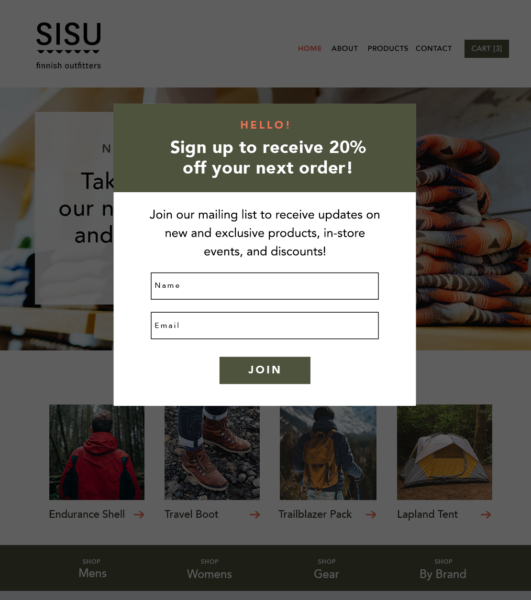
With the rise of social media platforms, messenger services, and chat apps over the past ten years, some may have expected retail email marketing to fall by the wayside. While these social media avenues can be effective marketing tools, don’t count out email anytime soon. Not only is the “O.G.” digital marketing tool surviving, but it’s also thriving.
Having a quality retail store email list has never been more important for small businesses. Whether starting from scratch or looking for ways to boost your audience, continuing to grow your list of prospects should remain a top priority.
Why it’s important to grow your retail store email list
Digital marketing strategy: those three words might make a retail business owner feel overwhelmed.
Competing with billion-dollar retailers and local establishments can feel discouraging and impossible. The idea is to work smarter, not harder, in retail email marketing.
The number of emails per day across the world has not just remained consistent since 2017, the numbers have increased with 376 billion daily emails projected by 2025. With this growth, email click-through rates (CTRs) are correspondingly on the rise and outperforming the click-through rates of social media marketing efforts.
CTR for email is a simple but highly significant indicator in measuring the effectiveness of your email campaign and the quality of your retail email list.
Effectiveness of retail email marketing
Average CTRs vary across industries, but higher CTRs are always the goal. Small and medium-sized retail business owners have enough numbers to worry about. Constant Contact makes it quick and painless to determine the CTRs of a single email as well as the average click-through rate across a campaign of emails. We also provide you with tips to help increase your CTRs.
Measuring clicks and driving traction is great but they mean nothing without a solid retail store email list.
How to build an email list for ecommerce
Even if you are brand new to retail email marketing, you’re well-positioned for marketing in 2021. There are multiple ways to build an email list for ecommerce. You can and should use as many of them as possible. Let’s dive in.
The online form
Roughly 88 percent of online buyers abandon their shopping carts and leave sites without making a purchase. You won’t lose them if you use a call to action (CTA) to capture their email addresses. Whether it’s registering to receive a monthly newsletter or to claim an offer, use any of these example CTAs to prompt prospects to enter an email address in the form field:
- Register
- Sign up
- Opt-in
- Subscribe
- Log in
- Start trial
- Join
- Shop now
- Redeem now
- Book a class
- Schedule a visit
You can also include a coupon or an offer when appropriate.
Depending on the specific CTA, forms should be embedded on homepages and the corresponding landing pages and should present themselves as pop-ups. Implement as many options as possible to maximize your potential amount of email captures.

Lead Generation Landing Pages
Another way to grow your retail email list online is with a Lead Generation Landing Page. A landing page is essentially a very simple, focused website with one purpose. In this case, the purpose is to collect leads for your email list. You can drive traffic to these Landing Pages from a social media ad, by sharing the URL on a flyer or in-store signage, or even by asking current email subscribers to forward the link to their friends.
A Lead Generation Landing Page is also a great choice for brick-and-mortar retail stores that don’t yet have a full website up and running yet, but still want to collect leads online.
The classic paper sign-up form
If it ain’t broke, don’t fix it. Don’t underestimate the old-school paper sign-up sheet. All you need to do is manually input each person’s information into your retail store email list.
At the register
Simply have a paper form to “join our email list” and a pen handy. Place the sheet at the register, by the entry/exit door, at the cream and sugar counter, or wherever it makes sense for you. We’ve even created sign-up sheet templates for a head start.
Biz card drop
Like email, business cards are still hanging around. Place a box or fishbowl at the register for business cards, particularly if you’re located in a business district.
The contest or giveaway
When all other options feel exhausted, throw another giveaway at them. A gift card, hot-button item, swag bag, or whatever fits your company. Use any and all of the methods above to promote the contest. You can get creative and also offer incentives for current customers to promote it as well.
Facebook lead ads
Prospects can also follow CTAs to connect with your brand on social media. Growing new social media followers increases the possibility of eventually capturing their email addresses. If you use Constant Contact, Facebook lead ads can be created and posted straight from your account. Use a CTA and a very brief form with one to two fields to capture the info of relevant users and grow your email lists with Facebook.
Make new friends but keep the old
While focusing on growing your retail store email list with new prospects, maintaining your list of current customers is equally important. Your work to capture new contacts will be a waste if the “old” customers get left behind.
The digital relationship you foster with loyal supporters can lead to new business. Nearly 80 percent of business consistently comes from 20 percent of your customers. What does that mean? The loyal return, and you can use them.
Referral programs
Your loyal customers continue to spend their dollars on your product. They don’t necessarily need coupons and offers to keep coming back, but retail referral programs only help the odds. Using a referral program is the epitome of working smarter, not harder. Brands have harnessed this technique to the full with social media influencing.
Referral program techniques
Direct referral link: For each customer, generate a unique link that traces back to them and create an incentive to share that link. When a friend clicks and makes a purchase, reward the initial customer with loyalty points, account credit, coupons, offers, etc.
Unique offer code: Each of your customer accounts is associated with a particular code. It could include the customer’s name, a combination of numbers, etc. Associate these codes with an offer. If a new customer uses the code to purchase, they benefit with a percentage off. The original owner of the code also receives a benefit of your choosing.
Old-fashioned referral cards: This goes out to the brick & mortar companies that can champion the paper sign-up sheet. Create physical cards with existing customers’ names to personally pass on to friends and family. To use the card, the friends must write their email addresses in the space provided and present the card at checkout to receive the special offer.
Wrapping up
The overwhelming feelings surrounding building your retail store email list and effective email marketing should now be fleeting. Just start with one thing at a time. You will soon find what email capture techniques work best for you and your business.




